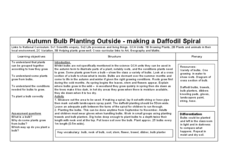Curated OER
Fields of Daffodils
Students discuss the characteristics of a community. They discuss their local neighborhood, and brainstorm ways to help others in their community. Using recycled file folders and paint, students create their own daffodils. They discuss...
Curated OER
Autumn Bulb Planting Outside - Making a Daffodil Spiral
Students plant daffodil bulbs. In this gardening activity, students work outside to plant daffodil bulbs in the autumn so that they can grow roots and emerge by spring.
Curated OER
Daffodil--Back Line Drawing
In this coloring worksheet, learners examine a detailed black line drawing of a flower which is labeled "daffodil." Students color the picture.
Curated OER
Daffodils: Print and Color
In this word recognition worksheet, students trace the word "daffodils," write the word independently, and color the picture of the daffodils.
Curated OER
Daffodil Coloring Page
In this flower coloring page, students examine a black line drawing of a single daffodil. Students color the picture that is labeled "daffodil".
Curated OER
Yellow Daffodils
For this early childhood yellow daffodils booklet worksheet, students color the 9 pictures, cut the pages out, and assemble the daffodil booklet that may be read again and again.
Macmillan Education
Understanding Poetry
William Wordsworth's "Daffodils" provides young poets with an opportunity to examine how a poet can use powerful images and poetic devices to create vivid pictures in the minds of readers.
Curated OER
Color the Daffodils
In this coloring worksheet, learners are asked to color three daffodils. Following the directions, students must use three different colors according to what they read.
Curated OER
Distinguishing Between Flowers
A branching key is a great way to classify different types of animals and plants! Fifth graders answer several yes/no answers about three different plants. They then create their own key to differentiate between an iris, a rose, and a...
Curated OER
The Bulbs: Camas and Daffodil
Fourth graders become aware of the importance of the camas bulb to the Nez Perce people, they learn the parts of plants, and gain understanding of the interdependence of Nature. They study about the possible causes and outcomes of global...
Curated OER
Structure and Function of Bulbs, Corms and Rhizomes
Students explore the concept of philanthropy and why people give. They investigate the importance of the tulip to Holland and the tradition of giving flowers away. They begin to explore the life cycle of tulips and dissect a bulb to...
Curated OER
Violets, Daffodils, Roses and Thorn
Fourth graders complete a variety of exercises and activities surrounding the scientific and artistic properties of the parts and processes of a plant/flower.
Curated OER
Challenge: Add in Any Other
In this addition worksheet, learners complete a set of 4 questions using information given about sets of daffodils planted and also complete a Math Mountain explore it related activity.
Curated OER
March Word Search
In this March word search worksheet, 3rd graders locate 20 word associated with the month of March that are hidden in the puzzle. They search for words such as daffodils, migrate, and Spring.
Curated OER
Non-Fiction Reading and Writing
In this non-fiction text worksheet, students read the passage about spring flowers. Students then underline the sentences about Daffodils and Primroses.
Curated OER
I Wandered Lonely as a Cloud Questions
For this reading comprehension worksheet, students respond to 6 short answer and essay questions based on the poem "I wandered lonely as a Cloud."
Curated OER
A Hidden Beauty
Expose the beautiful mystery of bulbs as young botanists learn all about these fascinating plants. They glean information from a short text before observing actual bulbs (consider an onion), and comparing their findings with predictions....
TLS Books
Dictionary Skills Review
Why do we use a dictionary? Your scholars will tell you why while demonstrating their dictionary skills. In addition to stating the purpose of using dictionaries, they will also show what they know about guide words, alphabetizing, and...
Cornell University
Garden Math
Young scientists must put their math caps on and figure out what fraction of each flower is in a raised flower bed. They must problem solve to simplify the fractions, and then graph the amount of flowers that are in different flower beds.
Curated OER
Flower Dissection
Beginning biologists pull a flower apart and familiarize themselves with the different reproductive structures. Why have them learn only from just a book or diagram when they can examine real samples? There is no link to the referenced...
Curated OER
Figurative Language #2
Identify figurative language in sentences that have been pulled out of a text. Looking at the sentence independently, can you tell which technique is being used? How do you know? Ninth graders look at 10 sentences that show simile,...
Curated OER
Writing a Letter
Here are three well-thought-out tasks intended to build good note taking and letter writing skills. The class reads three short letters, determines who wrote them (based on context) and takes notes as a pre-writing activity. They finish...
Garden Earth Naturalist Club
Parts of a Flower! Flower Dissection
Sometimes the best way to learn about plants is to see the different parts of a plant yourself. Groups of learners dissect flowers to answer questions about what they observe and what they wonder about their flower.
Soft Schools
Metaphor and Similes in Literature: A Challenge
After identifying the similes and metaphors in a series of lines from poems, individuals then explain what is being compared and the characteristics the two items share.
Other popular searches
- Daffodils Flower
- Life Cycle Daffodil
- Daffodil Parts and Diagram
- Daffodil Template
- Poem Daffodils
- Parts of Daffodils
- Art Daffodil
- Daffodils by Wordsworth
- Daffodil Diagram
- Daffodil Poem
- Daffodils Wordsworth
- The Daffodils

























